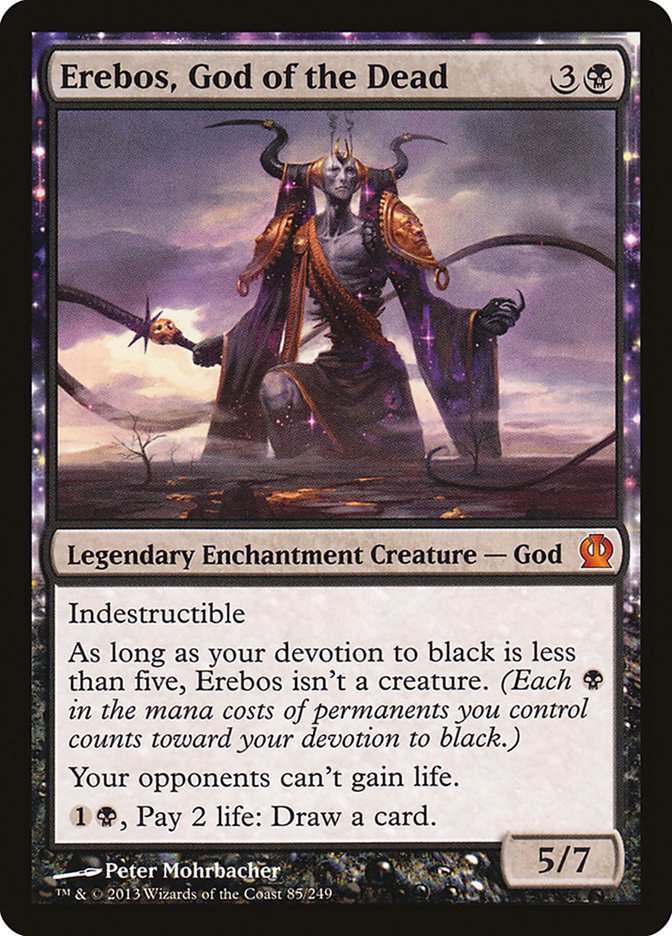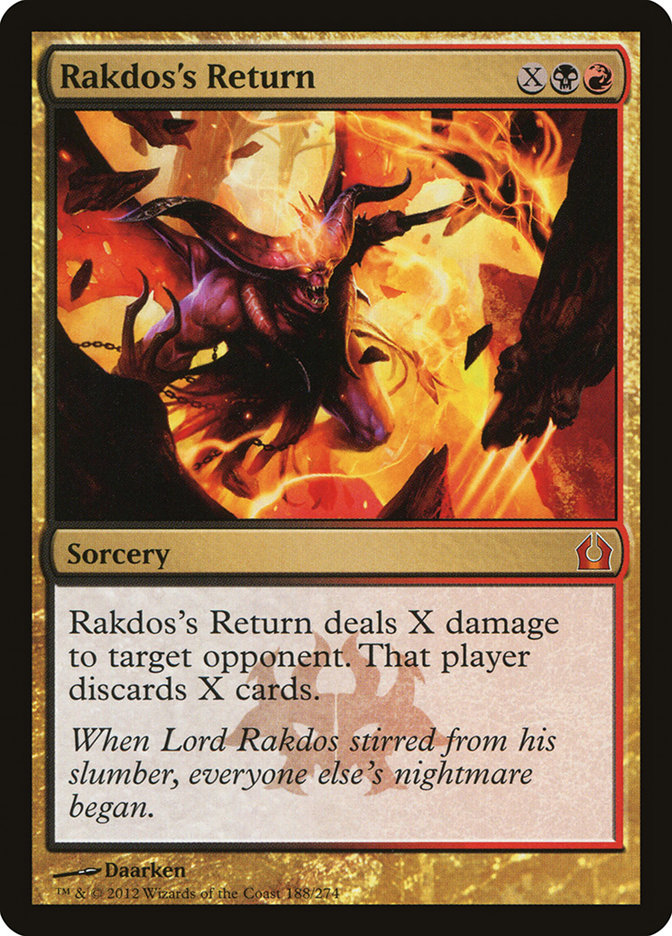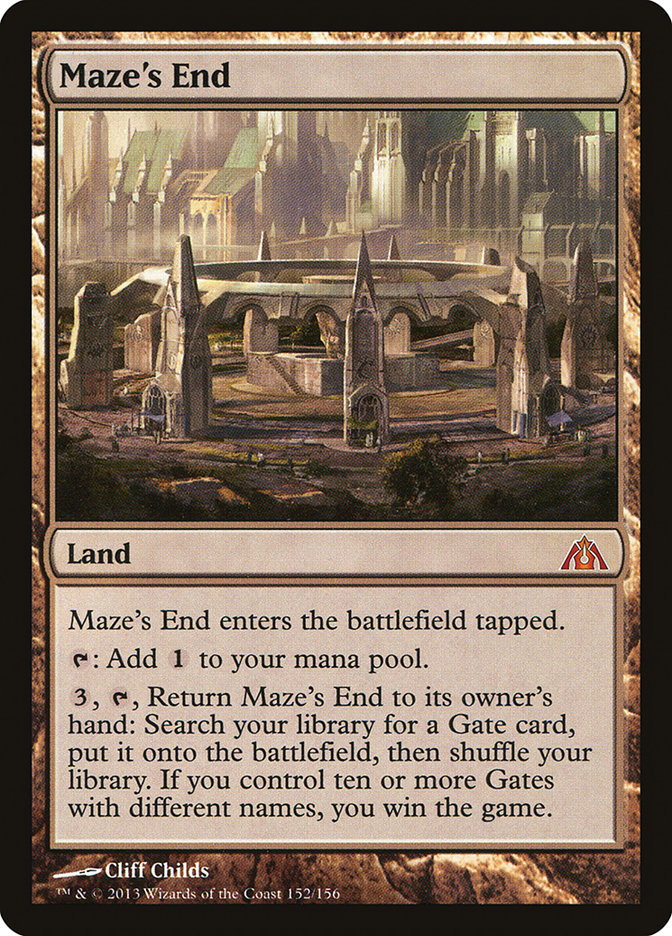So far these are the three things I’m most excited for in order when it comes to the new Standard:
1) Casting Read the Bones . . . then stopping, looking around at everyone sitting at the same table as me, and in a trembled voice murmuring, “I read the bones . . . I READ THE BONES,” because that KFC commercial is hilarious.
2) Casting Ashen Rider and then in my best Atreyu impression pointing forward while yelling, “FASTER, FALCORE! WE HAVE TO SAVE THE CHILD-LIKE EMPRESS!”
3) Brewing decks . . . I guess. *kicks rocks*
This is what I love about a new format: infinite possibilities!
We don’t know what’s good yet, and everything is completely untested except for a few Pro Tour Dragon’s Maze standouts. Initially our understanding was that decks like Esper Control and G/W Aggro were going to be the early frontrunners, but this year has something that previous years haven’t had:
VERSUS VIDEOS ALL DAY ER’EY DAY!
Last year Versus videos happened but not nearly in the frequency that they currently do, and in the last week we’ve already been given several with completely new archetypes that will match up quite well against already “established” decks of RTR/THS Standard. This shows that Theros along with M14 are going to shake things up to the point that the knowledge we had going into this format is pretty much moot. This is a good thing!
Around this time last year, I set out to find a deck in the new Standard that I loved, and every sign pointed me directly to Jund. It played the cards I loved in the color combination that I was comfortable with while giving me something that I felt like other decks were sorely lacking: control. Feeling like you’re in the driver’s seat is a particularly incredible advantage, and when you and a deck just click, it makes you believe you can win any match from any position. That type of power is what wins tournaments.
I took down the first major tournament of the new Standard in Florida last year around this time because I had what at the time felt like the most refined list of Jund in the room. My matches were all fairly easy, and I only suffered a single loss the entire afternoon. Winning it felt good because I knew that with some testing, trial and error, and a little bit of luck that I had worked on something special. Soon I started running into my Jund deck online being played by other people, including one cheeky fellow who called me a “scrub” after I beat him in the mirror match. He accused me of “netdecking.” I found this ironic. Enough of the trip down memory lane—I promise this serves a purpose.
My point is simple; if you can lock yourself on a deck in the next week or so, tweak it as metagame trends emerge, and become confident in it, you may achieve success with it on a grander scale. I say “may” because there is no sure thing; unless your first name is Reid and your last name is Duke, you probably can’t just pick up anything and win a tournament with it. Don’t worry. Most of us can’t do that either.
I decided that I needed a starting point for what I wanted to do this format: beat creature decks like Mono-Red and G/W Aggro. In a vacuum aggressive decks are always the best choice because they don’t screw around or try to be cute—they just focus on killing you quickly and do not dedicate time to setting up, instead budgeting their time to reduce your life to zero. It’s a blunt and effective strategy, and one you need to be ready for.
What were the three big decks last year when Standard rotated? G/B Zombies, R/B Bump (which also had Zombies in it,) and G/W Aggro. They all tried to end the game as fast as possible with efficient and cheap creatures backed with burn, or in G/W’s case disruption in the form of Thalia, Guardian of Thraben. That’s the case now, isn’t it? Very aggressive decks at the forefront with a peppering of the expected villains like Esper Control and U/W/R. How do we beat these decks?
Experiment #1: The Usual
The first deck I wanted to brew was Jund because it’s a safe choice and you can put yourself in a similar position with it this year as last year. A lot of the pieces are still there, namely great removal spells, very strong disruptive elements, and beefy creatures to end the game. Losing a card like Thragtusk could hurt a lot, but there are replacements that should do the trick. Olivia Voldaren exiting the format theoretically makes our deck weaker against creature-heavy decks, but how often did you play her and get a response of Searing Spear to her face?
Losing Farseek should be a death sentence, right? I’ve covered that, too. Allow me to introduce you to Jund 2.0 . . . or 3.0 . . . or like 6.0. Damn, there are a lot of incarnations of Jund!
Creatures (17)
Lands (24)
Spells (19)

This Jund deck I feel hits all the right spots in what an expected metagame has to offer. Earlier we talked about a bevy of aggressive decks spilling on to the scene, and Jund has traditionally been a very good deck at taking them out by playing tons of powerful removal. This build doesn’t skimp on the kill spells, and adding something new and special into the fray is the power of the scry mechanic. I love scry because of its versatility, and it excels in this deck by always helping you find an answer.
One of the old problems that Jund decks used to have was “drawing the wrong half of your deck.” Against control you were all Tragic Slips. When battling aggro decks you’d hit runner-runner Rakdos’s Return, and it could be very frustrating. One of the benefits of scry in a deck like this is that it can let you ship the useless tripe to the bottom and draw yourself into the cards you want to hit in a particular matchup. This turns a card like Magma Jet against a deck like Esper from a dead draw into a possible game-winner by letting you bottom two removal spells and getting you closer to your huge threats like Erebos, God of the Dead and Rakdos’s Return.
One thing that this deck does well is put the brakes on decks that pack smaller creatures. Desecration Demon has historically been a problem for red decks, and if you have a removal spell for any Firefist Strikers, you can almost assuredly brick wall their team, which can give you enough time for your removal and Scavenging Oozes to blow the doors off of their board.
Sylvan Caryatid is our new Farseek, and while the two-mana sorcery can never be replaced, this 0/3 wall can keep our life up and also accelerate us into bigger and better things. I like it for now.
The board is what you’d expect from a Jund deck: a few more pieces of removal for aggro decks and a bunch of cards for other midrange and control matchups. Anger of the Gods will shine against G/W decks because the exile clause takes Voice of Resurgence out of the picture, which is a pretty huge deal. If a huge emphasis is placed on enchantments, Golgari Charm might see its stock raise considerably, but if it turns out to be weak, it might just see itself become something as mundane as a Naturalize or Duress.
One of the concerns I have going forward with this deck is that dealing with Forge[/author]“]Purphoros, God of the [author name="Forge"]Forge[/author] seems like it will be an extreme pain. Thoughtseize is always an answer, but do you really want to take two damage against the decks that will play the red God? If this card lives up to the hype, I think we will need to seriously address the glaring hole he will leave.
Experiment #2: This Might Sound Crazy . . .
One deck that I’ve always hated more than life itself are the Turbo Fog decks that slimed their way into Standard from Block Constructed, boring me to tears by casting a Fog every turn until I inevitably was killed by stupid Maze’s End.
It’s so boring!
In this new Standard though, if we think that we’re going to see a ton of aggressive decks out of the gate, how do we best combat that?
We bore them to death!
Creatures (2)
Planeswalkers (2)
Lands (27)
Spells (29)
- 4 Fog
- 1 Elixir of Immortality
- 3 Supreme Verdict
- 3 Sphinx's Revelation
- 4 Druid's Deliverance
- 4 Urban Evolution
- 4 Riot Control
- 2 Swan Song
- 4 Defend the Hearth
Sideboard

Ewwwww . . . isn’t it ugly?
Well, that’s what I thought when I finished making this monstrosity, but the more I looked at it, the more I started to think this deck could actually be good right now. Why? I’m glad you asked, imaginary person that I’m talking to.
First and foremost, this deck doesn’t screw around with aggressive decks. Sixteen, count em’, sixteen Fog effects can halt a team for ages, not to mention teaming them up with Supreme Verdict to just keep their team completely shut off. That’s one reason to play this deck.
The second is that admittedly at the Pro Tour most people playing control decks were terrified of playing this deck because a land that happens to be a win condition is a piss-poor card to combat with a bunch of removal spells and counters. Aside from Pithing Needle and Encroaching Wastes, there is literally no way to interact with Maze’s End for a control deck, and oftentimes you will just goldfish them to death. The sideboard offers you a package to bring in when your Fogs come out, making sure that you have plenty of cards to clock them with while they scramble to beat you.
Swan Song in the main is your answer to the dreaded Forge[/author]“]Purphoros, God of the [author name="Forge"]Forge[/author]. One way to die to creatures is by them just Shocking you over and over again after getting through a few points of initial damage at the start of the game with their one- and two-mana creatures. Swan Song changes that dynamic by giving you a cheap and extremely versatile spell that plays into your game plan: prevent bad things from happening and give them a creature that you can Fog the damage away from. This keeps cards like Rakdos’s Return from just ruining your day and puts them in a bad place.
Overall I think this deck is going to catch a lot of people by surprise when the format shifts. Have you heard anyone talking about it? It is so far under the radar that people won’t even understand what you’re doing against them until you have a ton of Guildgates in play and are en route to victory.
It might sound like a gimmick, but this deck is real. Remember, the format has slowed down, and you won’t see as many turn 4 kills. Do you honestly think a midrange creature deck without disruption has a chance against something like this? Give it a shot!
Experiment #3: Post Your Own!
We want to know what you plan on battling with!
In the comment section, feel free to post your current new Standard brew. I’ll be personally going through each and every deck that you post and talking about what I like about it and what we could possibly change to make it better.
I’d love to get as many people involved in this as possible because yeah, I can write about decks and try to influence you, but I’d also like to have you influence me!
The deck that gets the most feedback and comes out looking the best will get a feature in this article next week, and the entire Internet will get a chance to see your masterpiece! Who knows? You might even be the guy or gal that creates the next big Standard deck. Choose wisely!
I’d love to see some new or wild decks on the block but would be happy even if it was something tried and true that you put a perfect personal spin on.
I can’t wait for this. Also feel free to tweet me your lists or critiques.
. . .
. . .
. . .
This week I’m so insanely excited to see what decks start coming out of the woodwork. This is usually the best time to be a Magic player because everything is so fresh and new and the possibilities seem endless. I love that.
Make sure you check out Anthony Lowry article this week, which will pick up where I left off, giving you more decklists to add to your gauntlet, because some of his brews are the best out there. The kid has a gift.
So get active this week and let’s make this the most supercaliswagilisticsexyhelladopeness format ever. Ya dig?
Catch ya on the flip-
Mark
Watch me stream! http://www.twitch.tv/Mark_Nestico
Check me out on Facebook! https://www.facebook.com/mnestico
Gaze in awe as I attempt to tweet things! @DynamoNestico



